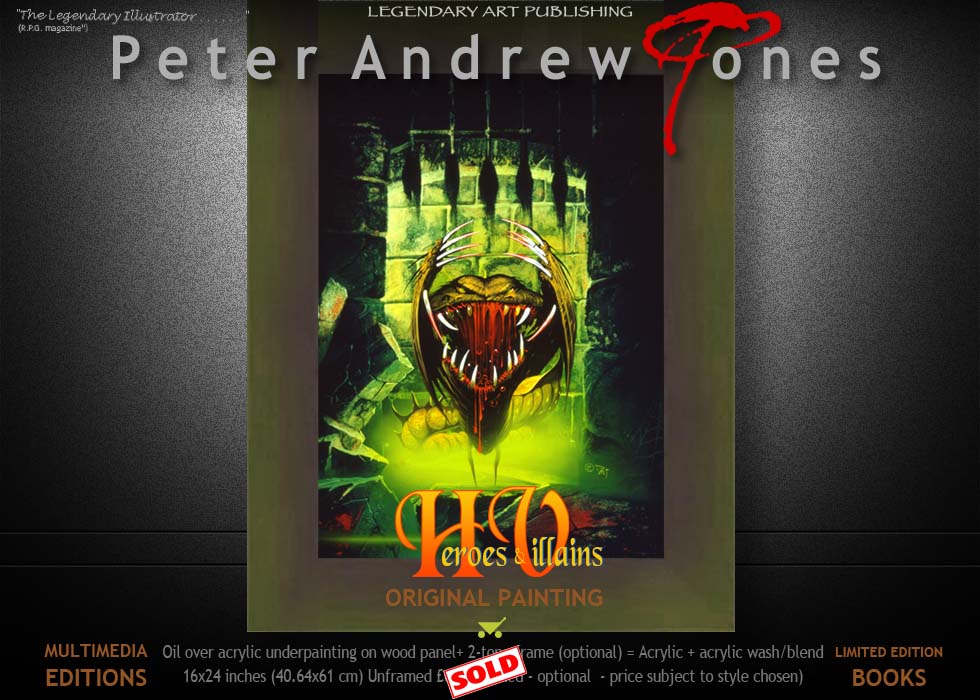
|
 Dungeon
Dweller Dungeon
Dweller
 (The Dungeons of Torgar) (The Dungeons of Torgar)
 By : Deborah Susan Jones : Editor By : Deborah Susan Jones : Editor
 At the time this picture was created, for the
Joe Dever Roleplay Gamebook series Lone Wolf, Peter had
developed a technique honed by a half-decade working in
film and TV and the background of which he calls a
"scene setter" which is a term used at the BBC in London
by program designers he worked with, on series such as
Captain Zep Space Detective and The Two Ronnies Show as
well as regional News in the South of England and which
derives from multi plane camera techniques, originated
by Disney and others decades earlier, and which the BBC
took a step further by using linked multiple cameras
instead of various sheets of glass through which one
camera filmed (a multi-plane camera). At the time this picture was created, for the
Joe Dever Roleplay Gamebook series Lone Wolf, Peter had
developed a technique honed by a half-decade working in
film and TV and the background of which he calls a
"scene setter" which is a term used at the BBC in London
by program designers he worked with, on series such as
Captain Zep Space Detective and The Two Ronnies Show as
well as regional News in the South of England and which
derives from multi plane camera techniques, originated
by Disney and others decades earlier, and which the BBC
took a step further by using linked multiple cameras
instead of various sheets of glass through which one
camera filmed (a multi-plane camera).
 Called "CSO" technique (colour separated
overlay) one camera is synced so that a specified
colour, typical but not exclusively blue, is unexposed
film allowing for an element filmed on a separate camera
(or several) to be syncronised with it. Called "CSO" technique (colour separated
overlay) one camera is synced so that a specified
colour, typical but not exclusively blue, is unexposed
film allowing for an element filmed on a separate camera
(or several) to be syncronised with it.
 Essentially, it is a matte technique. Essentially, it is a matte technique.
 The background was created
first, painted in acrylic, as it would have been if it had
been a piece for TV, shot on transparency so that it
could be used again and have different characters appear
over it, like actors on a stage walking in or off,
and then the foreground character was painted on. A
photoprint was then made and the monster character painted
on it in oil paint. The background was created
first, painted in acrylic, as it would have been if it had
been a piece for TV, shot on transparency so that it
could be used again and have different characters appear
over it, like actors on a stage walking in or off,
and then the foreground character was painted on. A
photoprint was then made and the monster character painted
on it in oil paint.
 The CSO technique became
frequently used at the BBC by the artist in the 80s and
his "scenesetters" typically had actors walking around in
them and in the case of the Captain Zep Space Detective
series had overlay foreground characters drawn in felt tip
markers by Trevor Goring producing a blend of comic strip
foreground and imaginative realistic backgrounds and
live action actors also interacting with the
drawn characters, a visual combination created as the
program style, invented by he two artits and a then senior
BBC designer called Ray Ogden. The CSO technique became
frequently used at the BBC by the artist in the 80s and
his "scenesetters" typically had actors walking around in
them and in the case of the Captain Zep Space Detective
series had overlay foreground characters drawn in felt tip
markers by Trevor Goring producing a blend of comic strip
foreground and imaginative realistic backgrounds and
live action actors also interacting with the
drawn characters, a visual combination created as the
program style, invented by he two artits and a then senior
BBC designer called Ray Ogden.
 The Captain Zep series was
Peter's introduction to the CSO technique when invited by
Trevor, a colleague from his St. Martins School of Art
years, and his quick and intrinsic grasp of the
technique led to many more TV projects that followed at
the BBC and soon his reputation with the technique led to
commercial projects for companies such as Ford UK. The Captain Zep series was
Peter's introduction to the CSO technique when invited by
Trevor, a colleague from his St. Martins School of Art
years, and his quick and intrinsic grasp of the
technique led to many more TV projects that followed at
the BBC and soon his reputation with the technique led to
commercial projects for companies such as Ford UK.
 Eventually, after half a decade
of using the technique in TV the artist felt the time had
come to move on and take the concept of multi-layer use
into the book cover and computer game areas where the
image was visualised as a multi-layer scene but actually
painted as one piece rather than split into actual
physical layers and to this day, where deemed appropriate
and useful, he still visualises some paintings this way. Eventually, after half a decade
of using the technique in TV the artist felt the time had
come to move on and take the concept of multi-layer use
into the book cover and computer game areas where the
image was visualised as a multi-layer scene but actually
painted as one piece rather than split into actual
physical layers and to this day, where deemed appropriate
and useful, he still visualises some paintings this way.
 Deborah Susan Jones Deborah Susan Jones

|
 |






